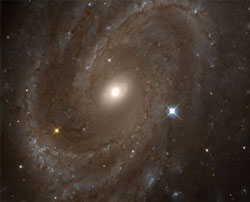The Gravitational Suppression (GraS) Hypothesis
Despite its successes in explaining the richness and variety of the
large-scale structures in the Universe, the Cold Dark Matter (CDM)
paradigm is known to show some discrepancy with observations on the
smallest (~ kiloparsec) scales. In collaboration with Christian Marinoni
(CPT, Marseille) I have formulated gravitational suppression (GraS)
hypothesis, namely, that the effective gravitational interaction
betweendark matter and visible matter is suppressed on subgalactic
(~ kpc) scales. Such a simple phenomenological hypothesis, while
consistent with the observed large scale structures and CMB
surface brightness galaxies and regulates the baryon fraction inside dark matter halos of different sizes. We have also considered the velocity scales measurable in dwarf spheroidal galaxies and found that, compared to Newtonian predictions, GraS provides a better description of data, when realistic dark matter density profiles are considered. Later studies on different sets of galaxies, while confirming the improvement of the velocity curves fitting, estimate as ``unphysical" the mass parameter fitted with GraS.

References:
F. Piazza and C. Marinoni, ``Model for gravitational interaction between dark matter and baryons”, Phys. Rev. Lett. 91 141301 (2003) hep-ph/0304228
F. Piazza and C. Marinoni, ``The GraS hypothesis: A Model for dark matter - baryons gravitational interaction.” proceedings of 4th International Conference on Where Cosmology and Fundmental Physics Meet, Marseille, France, 23-26 Jun 2003 astro-ph/0309490
C. Marinoni and F. Piazza, ``The Gravitational suppression hypothesis: Dynamical analysis in the small velocity regime” astro-ph/0312001
Talks:
``Baryons and Dark Matter: a modification of Gravity at subgalactic scales''
- Exploring the Universe, Rencontres de Moriond, La Thuile (Italy), April 4-10, 2004
- Where Cosmology and Fundamental Physics meet, IUFM, Marseille (France), June 23-26, 2003
- Physical Cosmology, Blois (France), June 15-20, 2003
See Also:
Et si Newton n’avait pas tout prevu?” (“And if Newton had not foreseen everything?”)
Ćecile Bonneau, Science & Vie, 1038 54 (March 2004)
C. F. Martins and P. Salucci, ``Analysis of Rotation Curves in the framework of the Gravitational Suppression model”, Phys. Rev. Lett. 98 151301 (2007). hep-ph/0611028